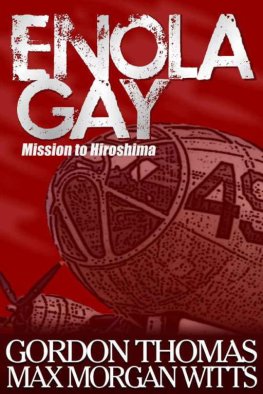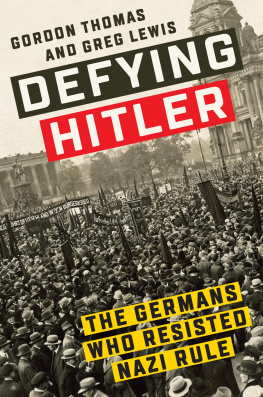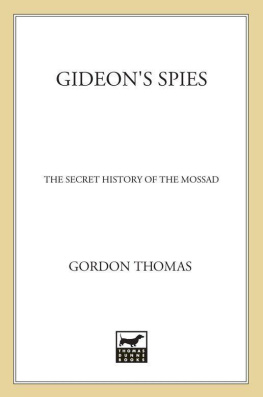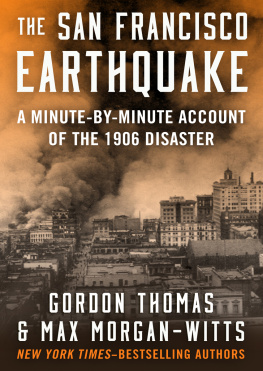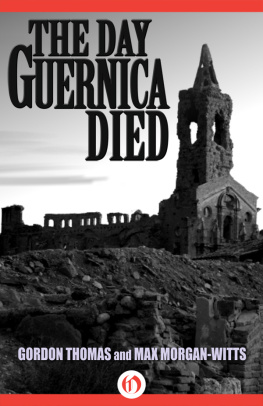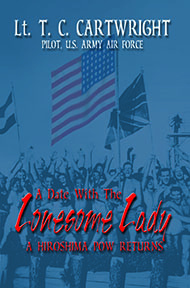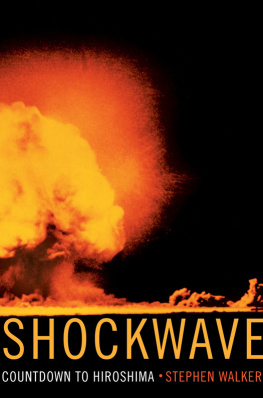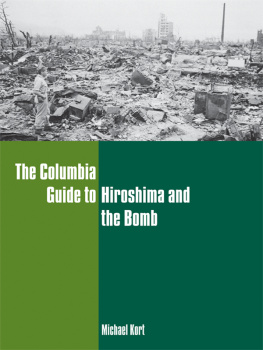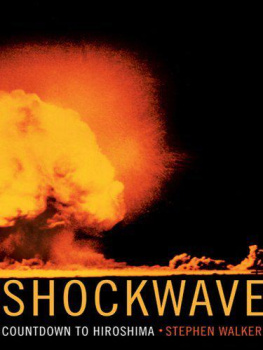Gordon Thomas and Max Morgan Witts

ENOLA GAY
Mission to Hiroshima
On August 2, 1939, a month before World War II began in Europe, Albert Einstein signed a letter addressed to President Franklin Delano Roosevelt. Couched in careful terms, the letter stated that recent nuclear research indicated extremely powerful bombs of a new type, based on uranium, might soon be possible. Einstein warned that secret work with uranium was going on in Nazi Germany. He urged that similar American research be accelerated.
Alexander Sachs, economist, financier, and friend of Roosevelt, agreed to deliver the letter to the president. Before he could do so, war in Europe broke out, and Roosevelt was unable to see him until mid-October. Then, after much persuasion by Sachs, Roosevelt marked Einsteins letter for action.
The first result of the presidents decision was the expenditure of just six thousand dollars. It bought graphite, essential for one of the early experiments that would, in time, lead to the atomic bomb. Substantial funds for the specific purpose of producing such a bomb were first authorized by Roosevelt on December 6, 1941.
Next day came Pearl Harbor. Roosevelt vowed vengeance. Remember Pearl Harbor became the rallying cry.
By the summer of 1942, it was clear that enormous amounts of money and effort would be required to build an atomic bomb. Huge manufacturing and processing plants had to be erected in remote areas to produce the sometimes dangerous materials required; research work in widely scattered university and commercial laboratories had to be initiated and put on a wartime footing; new laboratories needed to be created. And all in the utmost secrecy.
A cover name was invented for the project: the Manhattan Engineer District, later simplified to the Manhattan Project.
In October 1942, Site Y, Los Alamos, in the New Mexico desert, was chosen by physicist J. Robert Oppenheimer, a former pupil at the Los Alamos Ranch School for Boys, for his key research laboratory. His old classrooms would come to be used by eminent scientists, among them Enrico Fermi, Edward Teller, and that other giant of European physics, Niels Bohr.
It was Fermi who masterminded the crucial experiment on December 2, 1942, that produced the chain reaction needed to make an atomic bomb. He conducted his experiment on a bitterly cold day in an unused squash court at the University of Chicago. There were fears that the city itself might be endangered by the nuclear energy released. But the reaction was controlled, and scientists had demonstrated that when a uranium atom splits, it releases neutrons which can themselves then split more uranium atoms, creating the chain reaction. They formally christened this process The K Factor; among themselves they called it The Great God K.
In secret war plants during the following months a sense of urgency hovered over the complex processes for producing the relatively small amounts of uranium 235 needed to make atomic bombs. Plutonium, also suitable for atomic weapons, was being produced as well.
Roosevelt backed the project without the knowledge of Congress or the electorate. Funds for the venture were disguised in the federal budget. Eventually, two billion dollars would be spent in financing the work.
By 1944, a deep division was brewing among the scientists. Those now opposed to the military use of their research included Niels Bohr, who, in late August 1944, asked Roosevelt to authorize the sharing of U.S. atomic secrets with the worlds scientific community. He believed science belonged to the world.
At about the same time during the summer of 1944, uranium 235 was beginning to be produced in the quantities required for a weapon. Success seemed in sight. The problem of how to enclose The Great God K in a bomb casing was being dealt with. If, despite the qualms of some of the scientists, work was to go forward, the time had come to choose the man to train and lead the men who would drop the bomb.
Activation
SEPTEMBER 1, 1944,
TO JUNE 27, 1945
The commanding general of the Second Air Force, Uzal G. Ent, looked up as Colonel John Lansdale of U.S. Army Intelligence led Paul Tibbets into his office.
He glanced inquiringly at the intelligence officer.
Lansdale nodded.
General Ent then introduced the two men seated beside his desk. One was U.S. Navy Captain William Deak Parsons, whom he described as an explosives expert but who was, in fact, one of the most influential men in the Manhattan Project; the other was a civilian, Professor Norman Ramsey, a twenty-nine-year-old Harvard physicist.
Lieutenant Colonel Paul Tibbets was struck by Ramseys comparative youth; he had always associated scientists with gray hair and stooped shoulders. To Tibbets, the two men looked fit enough to fly combat, even if Parsonss baldness made him appear older than his forty-four years. And it seemed strange that this naval captain should be involved in what appeared to be an Army Air Force meeting.
Have you ever heard of atomic energy? Ramsey had the firm, incisive voice of a natural tutor.
Yes, said Tibbets.
How?
I majored in physics, so I know the atomic scale.
There was an expectant pause.
What do you know of the present situation in the field? asked Parsons.
Tibbets looked at General Ent. There was no encouragement there. A few days earlier, when Ent first became aware of the Manhattan Project, he himself had been warned he would be court-martialed if any leak of information were traced to him. Tibbets looked to Lansdale, who gave a barely perceptible nod.
As confidently as he could, Tibbets began to speak. He understood there had been some experimenting by the Germans to try to make heavy water so that they could split the atom.
Good. Ramseys gentle praise was more suited to the campus than the bleak office of a fighting general. He paused, weighing his words, a mannerism Tibbets would come to recognize.
Ramsey continued. The United States has now split an atom. We are making a bomb based on that. The bomb will be so powerful that it will explode with the force of twenty thousand tons of conventional high explosive.
General Ent then told Tibbets he had been chosen to drop that bomb.
It was September 1, 1944. The place was U.S. Army Second Air Force Headquarters, Colorado Springs.
Only moments before this conversation, Lansdale had led Tibbets into the cloakroom adjoining General Ents office. There, Lansdale had asked Tibbets a highly personal question.
Tibbets had given no visible reaction. Nevertheless, he was stunned. How did this stranger know of that private event of tenor was it twelveyears ago; an experience of such a passing nature that he himself could not now exactly remember its date? Why had Lansdale been probing something that had happened all those years back?
Tibbets recognized that this assault upon his privacy, his sense of self-respect, was calculated. But how should he cope with it?
He knew that Lansdales question had nothing directly to do with military intelligence. Therefore, he would be perfectly justified in not answering. Then he could walk out, unchallenged, through one of the two doors in the cloakroom. That door would return him to the conventional military world where nobody would dare ask such an intimate question of a much-decorated war hero.
Tibbets decided to tell the truth. Yes. I was once arrested by the police in North Miami Beach.
What for?
The chief of police at Surfside caught me in the back of an automobile with a girl, confessed Tibbets.

